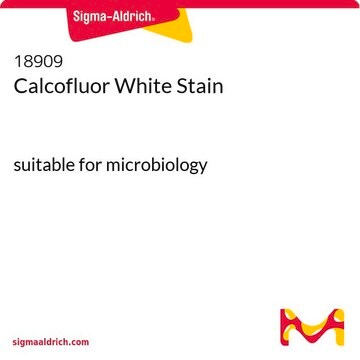Mayer's Mucicarmine Stain Solution is used to detect epithelial mucins and mucins secreting adendocarcinomonas and to demonstrate Cryptococcus neoformans and other fungi. The staining procedure involves placing a drop of the solution on a clean slide, then preparing and observing the stained fungal culture under a microscope.
41325
Mayer′s Mucicarmine Stain Solution
for microscopy
Synonim(y):
Mucicarmine Stain Solution according to Mayer
Wybierz wielkość
356,00 zł
Wybierz wielkość
About This Item
356,00 zł
Polecane produkty
klasa czystości
for microscopy
Poziom jakości
linia produktu
BioChemika
Formularz
liquid
okres trwałości
limited shelf life, expiry date on the label
metody
microbe id | staining: suitable
przydatność
suitable for microscopy
fungi
Zastosowanie
food and beverages
hematology
histology
temp. przechowywania
room temp
Opis ogólny
Komponenty
Carmine 1 g, Aluminum chloride 0.5 g, water 2 ml
Hasło ostrzegawcze
Danger
Zwroty wskazujące rodzaj zagrożenia
Zwroty wskazujące środki ostrożności
Klasyfikacja zagrożeń
Eye Dam. 1 - Skin Corr. 1B
Zagrożenia dodatkowe
Kod klasy składowania
8B - Non-combustible corrosive hazardous materials
Klasa zagrożenia wodnego (WGK)
WGK 1
Temperatura zapłonu (°F)
Not applicable
Temperatura zapłonu (°C)
Not applicable
Środki ochrony indywidualnej
Faceshields, Gloves, Goggles, type ABEK (EN14387) respirator filter
Wybierz jedną z najnowszych wersji:
Masz już ten produkt?
Dokumenty związane z niedawno zakupionymi produktami zostały zamieszczone w Bibliotece dokumentów.
Klienci oglądali również te produkty
-
What is the Protocol for using Mayers Mucicarmine 41325 for staining fungi?
1 answer-
Helpful?
-
-
Please provide the protocol for histology
1 answer-
Formulation 41325 contains carmine (1 g), aluminum chloride (0.5 g), and water (2 ml). On the other hand, the formulation for HT3018 consists of certified carmine (10 g/L), aluminum hydroxide (10 g/L), and aluminum chloride (5 g/L) in ethanol (50% w/v), following Southgate's modification of Mayer's mucicarmine procedure. Dilution instructions for use are provided, indicating the need to dilute product 41325 with either 10 volumes of distilled water or preferably 50-70% alcohol just before use.
Helpful?
-
Active Filters
Nasz zespół naukowców ma doświadczenie we wszystkich obszarach badań, w tym w naukach przyrodniczych, materiałoznawstwie, syntezie chemicznej, chromatografii, analityce i wielu innych dziedzinach.
Skontaktuj się z zespołem ds. pomocy technicznej











